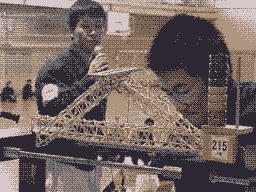Well, the saga continues. After starting to get a couple emails
from physics students wanting help deciding what sort of bridge to
try, I thought I would look around myself.
I stumbled across the Japan Aviation College's Annual competition.
The very interesting thing about this was the history. They have been
doing this for about 5 years. Each year, the winning bridge holds more
weight. From something like 20kg to 120kg!
The Japanese are pretty sharp!
It seems like there is always a dichotemy in design. Especially in
the fineness possible with mathematics. In a span the size of these
bridges, given the crudeness of the construction method and the inherent
weakness in the materials, what is more important, the exact shape of
the curve, mathematically speaking, or the curve that maximizes the
strengths of the building components?
The restrictions and rules of competitions vary greatly.
Two things come to mind when I consider these differences. How will
the bridge be tested? Is there a maximum weight restriction and will
there be an award given for the best ratio of weight held to bridge weight.
The winning design seems to maximize the bridge design for the contest
rules and the strengths of the building components.
In the case of the animated loop in the corner of this page, notice the
simple triangular truss. The triangle is one of the strongest shapes in
math or nature.
I also wonder, from seeing the testing setup, whether the bridge is
allowed to exert a lateral force on the testing table. I think this would
be a distinct advantage. When I was a boy, I used to climb up the doorway
of our kitchen by just putting one foot on either side and wedging my weight
between them. If the toothpick bridge is allowed to press laterally on the
table, then the tension aspect of the base of the triangle may not be doing
its job.

 Lars' Creative Warehouse
Lars' Creative Warehouse

 Lars' Creative Warehouse
Lars' Creative Warehouse